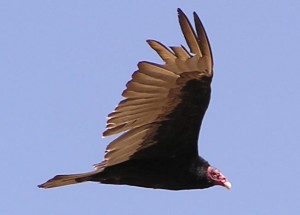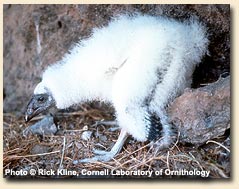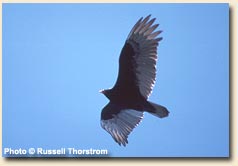Other: Other Related Research
Turkey Vulture - Cathartes Aura
By Cori Arnold (05/11/09 14:45:41)
Related animal: Turkey Vulture
The Turkey Vulture can be found all over the U.S. They have a wide wingspan averaging from 68-72 inches and weighing roughly no more than three pounds. This rapture rarely flaps it wings, but rather soars high overhead. This animal can most commonly be found in desert areas, forests, and subtropical regions. This bird lives throughout most of North and South America, depending on its breeding times. Over the past few generations this birds geographic range has expanded Northward.
At first glance of this bird has an ugly, bare, red head, but when in flight this creature is beautifully, graceful and a joy to watch. Looking up at this bird flying, one can easily mistake it for a hawk, since its flight carries a similar grace and dignity. "There are six subspecies of turkey vultures: three in North America and three in South and Central America. Cathartes aura septentrionalis is found in the eastern United States and west into Minnesota, Kansas, Oklahoma, and eastern Texas. Cathartes aura meridionalis is located mainly west of C. a. septentrionalis and into Baja California, excluding the lower Colorado River valley. Cathartes aura aura is found in the lower Colorado River valley, including most of Arizona, and in southern New Mexico and Texas. Cathartes aura ruficollis is found from Costa Rica south to northern Argentina and east of the Andes, Cathartes aura jota is found in the highlands of southern Colombia through Argentina, and Cathartes aura falklandica is found west of the Andes from Ecuador and Peru through Chile and on the Falkland Islands. (Palmer, 1988.)" The lifespan of this non-human animal is unclear and can range anywhere from an average of 10 years up to 17 years.
This bird is a scavenger and feeds primarily on carnage of already killed animals, ranging from, other birds, small animals, and some larger animals. "The Turkey Vulture forages by smell[citation needed], an ability that is uncommon in the avian world. It often will fly low to the ground to pick up the scent of ethyl mercaptan, a gas produced by the beginnings of decay in dead animals[citation needed]. The olfactory lobe of its brain, responsible for processing smells, is particularly large compared to that of other animals.[7] This heightened ability to detect odors allows it to search for carrion below the forest canopy. King Vultures and Black Vultures, which lack the ability to smell carrion, follow the Turkey Vulture to carcasses. The Turkey Vulture arrives first at the carcass, or with Greater Yellow-headed Vultures or Lesser Yellow-headed Vultures, which also share the ability to smell carrion[citation needed]. It displaces the Yellow-headed Vultures from carcasses due to its larger size,[30] but is displaced in turn by the King Vulture, which makes the first cut into the skin of the dead animal. This allows the smaller, weaker-billed, Turkey Vulture access to food, because it cannot tear the tough hides of larger animals on its own. This is an example of mutual dependence between species.[31] (Wikipedia.)" The Turkey Vulture will cover a span of area as its home until there is no longer food/carrion available for it. Than it moves on to a location were carnage can be abundant for the time being. Their home range is significantly larger in non-agricultural areas.
Many individuals are afraid of the Turkey Vulture, believing that they carry diseases from killing their prey, but they never actually kill their prey and their bodies breakdown any disease which they may have contracted from their prey.
"The Turkey Vulture species receives special legal protections under the Migratory Bird Treaty Act of 1918 in the United States,[8] by the Convention for the Protection of Migratory Birds in Canada,[37] and by the Convention for the Protection of Migratory Birds and Game Mammals in Mexico.[37] In the USA it is illegal to take, kill, or possess Turkey Vultures, and violation of the law is punishable by a fine of up to 15,000 US dollars and imprisonment of up to six months.[36] It is listed as a species of Least Concern by the IUCN Red List. Populations appear to remain stable, and it has not reached the threshold of inclusion as a threatened species, which requires a decline of more than 30 percent in ten years or three generations.[1](Wikipedia.)"
Turkey vultures do not have a large range of vocabulary and most of what can be understood of them is grunts, hissing, and barking sounds. These are typically used to deter predators. During mating visual cues are primarily used. To see a sample of their calls, visit: http://www.allaboutbirds.org/guide/Turkey_Vulture/id
Palmer, R. 1988. Handbook of North American Birds, Volume 4. New Haven and London: Yale University Press.
Wikipedia. Turkey Vulture. http://en.wikipedia.org/wiki/Turkey_Vulture.
[Write Comment]
By Cori Arnold (05/11/09 14:45:41)
Related animal: Turkey Vulture
The Turkey Vulture can be found all over the U.S. They have a wide wingspan averaging from 68-72 inches and weighing roughly no more than three pounds. This rapture rarely flaps it wings, but rather soars high overhead. This animal can most commonly be found in desert areas, forests, and subtropical regions. This bird lives throughout most of North and South America, depending on its breeding times. Over the past few generations this birds geographic range has expanded Northward.
At first glance of this bird has an ugly, bare, red head, but when in flight this creature is beautifully, graceful and a joy to watch. Looking up at this bird flying, one can easily mistake it for a hawk, since its flight carries a similar grace and dignity. "There are six subspecies of turkey vultures: three in North America and three in South and Central America. Cathartes aura septentrionalis is found in the eastern United States and west into Minnesota, Kansas, Oklahoma, and eastern Texas. Cathartes aura meridionalis is located mainly west of C. a. septentrionalis and into Baja California, excluding the lower Colorado River valley. Cathartes aura aura is found in the lower Colorado River valley, including most of Arizona, and in southern New Mexico and Texas. Cathartes aura ruficollis is found from Costa Rica south to northern Argentina and east of the Andes, Cathartes aura jota is found in the highlands of southern Colombia through Argentina, and Cathartes aura falklandica is found west of the Andes from Ecuador and Peru through Chile and on the Falkland Islands. (Palmer, 1988.)" The lifespan of this non-human animal is unclear and can range anywhere from an average of 10 years up to 17 years.
This bird is a scavenger and feeds primarily on carnage of already killed animals, ranging from, other birds, small animals, and some larger animals. "The Turkey Vulture forages by smell[citation needed], an ability that is uncommon in the avian world. It often will fly low to the ground to pick up the scent of ethyl mercaptan, a gas produced by the beginnings of decay in dead animals[citation needed]. The olfactory lobe of its brain, responsible for processing smells, is particularly large compared to that of other animals.[7] This heightened ability to detect odors allows it to search for carrion below the forest canopy. King Vultures and Black Vultures, which lack the ability to smell carrion, follow the Turkey Vulture to carcasses. The Turkey Vulture arrives first at the carcass, or with Greater Yellow-headed Vultures or Lesser Yellow-headed Vultures, which also share the ability to smell carrion[citation needed]. It displaces the Yellow-headed Vultures from carcasses due to its larger size,[30] but is displaced in turn by the King Vulture, which makes the first cut into the skin of the dead animal. This allows the smaller, weaker-billed, Turkey Vulture access to food, because it cannot tear the tough hides of larger animals on its own. This is an example of mutual dependence between species.[31] (Wikipedia.)" The Turkey Vulture will cover a span of area as its home until there is no longer food/carrion available for it. Than it moves on to a location were carnage can be abundant for the time being. Their home range is significantly larger in non-agricultural areas.
Many individuals are afraid of the Turkey Vulture, believing that they carry diseases from killing their prey, but they never actually kill their prey and their bodies breakdown any disease which they may have contracted from their prey.
"The Turkey Vulture species receives special legal protections under the Migratory Bird Treaty Act of 1918 in the United States,[8] by the Convention for the Protection of Migratory Birds in Canada,[37] and by the Convention for the Protection of Migratory Birds and Game Mammals in Mexico.[37] In the USA it is illegal to take, kill, or possess Turkey Vultures, and violation of the law is punishable by a fine of up to 15,000 US dollars and imprisonment of up to six months.[36] It is listed as a species of Least Concern by the IUCN Red List. Populations appear to remain stable, and it has not reached the threshold of inclusion as a threatened species, which requires a decline of more than 30 percent in ten years or three generations.[1](Wikipedia.)"
Turkey vultures do not have a large range of vocabulary and most of what can be understood of them is grunts, hissing, and barking sounds. These are typically used to deter predators. During mating visual cues are primarily used. To see a sample of their calls, visit: http://www.allaboutbirds.org/guide/Turkey_Vulture/id
Palmer, R. 1988. Handbook of North American Birds, Volume 4. New Haven and London: Yale University Press.
Wikipedia. Turkey Vulture. http://en.wikipedia.org/wiki/Turkey_Vulture.

| 
Baby Turkey Vulture |

Turkey Vulture in flight; what to look for when your standing underneath this bird. | |

Map of animals territories | 
|